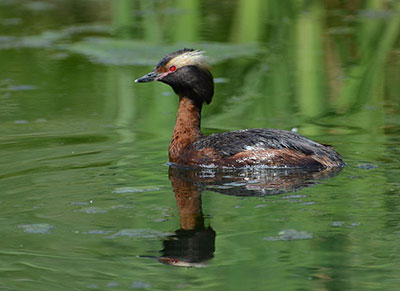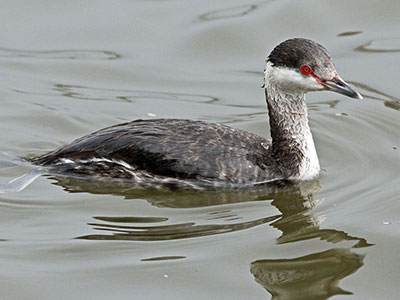Horned Grebe
(Podiceps auritus)
Description & Range:
The Horned Grebe has a duck like form. With a two foot wingspan, the Horned Grebe is a moderate-sized bird which is easy to spot. The male has a reddish brown body with a black head with a red ring around the eyes and distinct buffy (yellowish white) stripe horizontal from bill to the back of head. The female has a dark almost black upper body with a white underbelly and neck. Only the crown of the female’s head is black but retains the red eye ring with white from the eye down the length of the neck. The legs are placed far back of the body to help with diving in both sexes.

Male Horned Grebe by Connor Mah, Wikimedia Commons
Horned Grebes spend their summers from Alaska down through much of Western Canada. In the winter, they then migrate to the coasts in the eastern and southern United States. Some birds also reside in California for the winter. In Maryland, Horned Grebes can be seen during the winter and early spring months in coastal waters.
Habitat:
Horned Grebes typically are seen in pairs on open waters like the Chesapeake Bay and the surrounding river and stream systems often diving and surfacing with food items. Horned Grebes typically nest in wetlands surrounding lakes and ponds.
Diet:
Like other grebes, the Horned Grebe primarily eats small fish, insects, and other small aquatic animals. Generally, they consume aquatic insects during the summer and fish and crustaceans in the winter.

Female Horned Grebe courtesy of Dick Daniels
Reproduction:
Horned Grebes breed mid-May through early October. They construct floating nests from sedges and reeds in their habitat, usually anchoring the nest to floating vegetation or to lily pads. The breeding pair is monogamous and will lay one clutch of 3 to 8 eggs. Both parents are involved with nest construction and will continually maintain and update the needs of the nest. Incubation lasts 25 to 30 days after which the chicks will hatch and be reared for a few days until they can forage for themselves.
Behavior:
Horned Grebes are great swimmers and divers. They can travel up to 600 feet under water and can stay submerged for up to 3 minutes. To take off, Horned Grebes must run along the surface of water to fly.
Sounds:
The Horned Grebe makes a loud, nasal "aaarrrh" descending in pitch, and a pulsing trill. It is usually silent in winter.
Did you know?
Horned Grebes and other grebes carry their young on their backs. They even do this when diving by tucking the chicks underneath their wings. Horned Grebes are migratory and typically migrate at night by themselves.